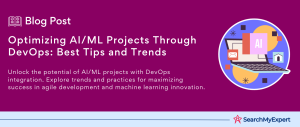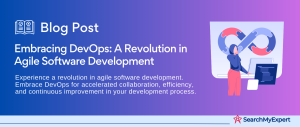DevOps: Bridging the Gap in Software Development
DevOps, a portmanteau of “Development” and “Operations,” marks a revolutionary shift in the world of software engineering. This methodology has emerged as a vibrant response to the limitations and challenges inherent in the traditional, siloed approach to software development and IT operations. Central to DevOps is the idea of breaking down barriers, and fostering a culture of collaboration and communication between developers and IT professionals.
The Core Principles of DevOps
At the heart of DevOps are five foundational principles:
- Automation:
Automating repetitive tasks to enhance efficiency and reduce the scope for human error. - Continuous Integration and Continuous Delivery (CI/CD):
Integrating code into a shared repository frequently, paired with an automated release process. - Collaboration and Communication: Encouraging seamless interaction between development and operations teams.
- Rapid Feedback Loops: Ensuring immediate feedback to quickly rectify issues.
- Learning and Experimentation:
Promoting a culture of constant learning and willingness to experiment.
Addressing the Pain Points of Traditional Software Development
DevOps arose as a solution to several critical pain points in traditional software development:
- Slow Release Cycles:
Traditional methods often lead to prolonged development cycles, delaying product releases. - Communication Gaps:
A lack of synergy between development and operations teams often results in misunderstandings and delays. - Inefficient Deployment Processes:
Manual processes were prone to errors, leading to unreliable deployment and operational challenges.
The Pre-DevOps Era: Understanding the Traditional Software Development Model
Before the advent of DevOps, the landscape of software development was markedly different. The era was dominated by the traditional software development model, a rigid, step-by-step approach to creating software. The most prevalent methodology in this era was the Waterfall model, characterized by its linear and sequential phases.
Key Characteristics of the Traditional Model
- Waterfall Methodology:
This approach involved distinct phases such as requirement gathering, design, implementation, testing, deployment, and maintenance. Each phase had to be completed before moving on to the next. - Separate Development and Operations Teams:
Development teams focused solely on writing code, while operations teams dealt with deployment and infrastructure management. The two rarely interacted or collaborated. - Manual Deployments:
Deploying software was often a manual process, involving the physical transfer of software from development to production environments.
Challenges of the Traditional Model
The Waterfall model and the siloed structure of teams brought several challenges:
- Long Development Cycles:
Due to its linear approach, the Waterfall model often led to extended development cycles. Changes in market needs or user requirements during the development process could not be easily accommodated, leading to delays. - Lack of Collaboration: The clear division between development and operations teams often resulted in a lack of communication and collaboration. This siloed approach led to misunderstandings and disjointed efforts.
- Difficulty in Troubleshooting Bugs:
When bugs were discovered in the production environment, it was challenging to troubleshoot them. The separation of teams meant developers were not always in tune with operational issues, complicating the resolution process.
The Pre-DevOps era, with its distinct methodologies and segregated teams, laid the foundation for the evolution of a more integrated and agile approach. This background provides a stark contrast to the collaborative, fast-paced world of DevOps, highlighting the need for a paradigm shift in software development and deployment processes.
The Rise of Agility and Lean Principles in Software Development
The landscape of software development began to transform with the introduction of Agile methodologies and Lean principles. This shift marked a significant departure from the rigid, linear approaches of the pre-DevOps era, paving the way for more dynamic and responsive software development practices.
Embracing the Agile Movement
The Agile movement emerged as a response to the limitations of traditional development methods. Its core focus includes:
- Iterative Development: Agile promotes short, iterative cycles of development, allowing for frequent reassessment and adaptation of plans.
- Continuous Delivery: Emphasizing the rapid and reliable delivery of software, Agile supports ongoing release of usable software to customers.
- Customer Feedback: Agile places a strong emphasis on customer involvement and feedback, ensuring that the development process is closely aligned with customer needs and expectations.
Agile methodologies, such as Scrum and Kanban, facilitated a more flexible and adaptive approach, a stark contrast to the Waterfall model.
Applying Lean Principles to Software Development
Lean principles, originally developed in the manufacturing sector, found a unique application in software development:
- Waste Reduction: Lean principles emphasize the importance of identifying and eliminating non-value-adding activities, streamlining processes, and optimizing resource utilization.
- Continuous Improvement (Kaizen):
This principle encourages ongoing, incremental improvements to processes, enhancing efficiency and quality over time. - Empowering the Team:
Lean advocates for giving teams the autonomy to organize and manage their work, fostering a sense of ownership and responsibility.
The integration of Lean principles into software development practices further enhanced the agility and responsiveness of teams. This shift laid the groundwork for the development of DevOps, which would combine the best of Agile and Lean practices with a focus on collaboration between development and operations teams.
Early Approaches to DevOps: Pioneers and Technological Innovations
As the DevOps philosophy began to take shape, several pioneers and early adopter companies played a crucial role in bridging the gap between development and operations. These trailblazers not only embraced the DevOps culture but also developed and utilized tools and technologies that became integral to its implementation.
DevOps Pioneers and Early Adopters
- Flickr and John Allspaw & Paul Hammond:
In 2009, at the O’Reilly Velocity conference, Allspaw and Hammond from Flickr presented a seminal talk, “10+ Deploys Per Day: Dev and Ops Cooperation at Flickr,” which is often cited as a pivotal moment in the DevOps movement. - Amazon and Netflix:
These companies were among the early adopters of DevOps practices. They demonstrated how implementing DevOps could lead to dramatic improvements in deployment frequency and system reliability. - Google and Site Reliability Engineering (SRE):
Google’s approach to SRE was an early form of what would become known as DevOps, emphasizing automation, measurement, and efficiency in operational tasks.
Technological Innovations Facilitating DevOps
The evolution of DevOps was accompanied by the development of tools and technologies that enabled automation, continuous integration, and continuous delivery (CI/CD).
- Automation Tools: Tools like Puppet, Chef, and Ansible were developed to automate the configuration and management of software and infrastructure, reducing manual efforts and errors.
- Continuous Integration (CI) Tools: Jenkins, a major CI tool, allowed developers to integrate code into a shared repository, where automated builds and tests could be run.
- Continuous Delivery and Deployment Tools:
Tools like Docker and Kubernetes revolutionized the way applications were containerized and deployed, enabling consistent environments from development through to production. - Monitoring and Logging Tools:
Splunk, Nagios, and ELK Stack (Elasticsearch, Logstash, Kibana) provided robust solutions for monitoring applications and infrastructure, crucial for maintaining system health and performance.
These early approaches to DevOps, both in terms of cultural shift and technological advancement, laid the foundation for a more integrated, efficient, and agile approach to software development and operations. The pioneers of this movement and the tools they developed played a significant role in shaping the modern landscape of DevOps, demonstrating the value of collaboration, automation, and continuous improvement in the software development lifecycle.
The DevOps Toolchain: Automating and Streamlining Software Development Workflows
The DevOps toolchain represents a suite of tools and technologies designed to automate and streamline the various stages of software development and deployment. This toolchain is critical in implementing the DevOps philosophy, enabling teams to work more efficiently, reduce manual errors, and maintain a high standard of quality throughout the development lifecycle.
Key Categories of the DevOps Toolchain
Version Control Systems (VCS)
- Purpose: Facilitate tracking and managing changes to software code.
- Examples: Git, Subversion, and Mercurial.
- Benefits: Enhances collaboration, enables version tracking, and supports rollback to previous versions if necessary.
Build Automation Tools
- Purpose:
Automate the process of converting code into executable builds. - Examples: Maven, Gradle, and Ant.
- Benefits:
Streamlines build processes, ensures consistency in build environments, and allows for faster development cycles.
Configuration Management Tools
- Purpose:
Automate the configuration and management of software and hardware resources. - Examples: Ansible, Puppet, and Chef.
- Benefits: Enables consistent configurations across environments, reduces manual configuration errors, and facilitates scalable infrastructure management.
Continuous Integration and Continuous Deployment (CI/CD) Tools
- Purpose:
Automate the integration of code changes and ensure reliable deployment to production. - Examples: Jenkins, GitLab CI, and CircleCI.
- Benefits:
Encourages small, frequent updates to the codebase, enhances quality through automated testing, and reduces the time-to-market for new features.
Monitoring & Logging Tools
- Purpose:
Provide real-time monitoring of applications and infrastructure; capture and analyze logs. - Examples:
Nagios, Splunk, ELK Stack (Elasticsearch, Logstash, Kibana). - Benefits: Helps in early detection of issues, aids in troubleshooting, and ensures high availability and reliability of services.
The DevOps toolchain is not just about individual tools, but how they interact and integrate to create a seamless, automated workflow. By leveraging these tools, organizations can significantly enhance their ability to develop, deploy, and manage complex software systems, embodying the essence of DevOps – efficiency, agility, and continuous improvement.
Cultural Shift and Collaboration: The Heart of DevOps
In the journey towards adopting DevOps, a critical aspect often overshadowed by the technicalities is the cultural shift it necessitates. DevOps is as much about people and their mindset as it is about tools and practices. This cultural transformation is pivotal in realizing the full potential of DevOps principles.
The Importance of Cultural Change in DevOps
- Breaking Down Silos: Traditional models often operate in silos where development and operations teams work in isolation. DevOps dismantles these silos, advocating for a unified approach.
- Fostering a Collaborative Environment:
DevOps encourages open communication and collaboration between teams, ensuring everyone is aligned towards common goals. - Shift in Mindset:
Moving from a task-oriented to a results-oriented mindset, where the focus is on the end product and its value to the customer. - Encouraging Innovation:
DevOps culture supports taking risks and learning from failures, fostering an environment of continuous learning and improvement.
Collaboration between Development and Operations
The essence of DevOps lies in its ability to bring development and operations teams together. This collaboration is facilitated through:
- Shared Responsibility:
DevOps blurs the lines between developing and operating software. Both teams share the responsibility for the software’s success, from conception to deployment and beyond. - Regular Communication: Regular meetings, joint planning sessions, and shared tools enable ongoing communication, ensuring both teams are on the same page.
- Cross-Functional Teams: Teams often consist of members with varied skills from both development and operations, promoting a deeper understanding and appreciation of each other’s challenges and contributions.
- Feedback Loops: Implementing short feedback loops ensures that any issues are quickly communicated and addressed, enhancing the overall quality and performance of the software.
The Future of DevOps: Emerging Trends and Advancements
As DevOps continues to evolve, it is shaping the future of software development and delivery in profound ways. Several emerging trends and technological advancements are playing a pivotal role in this evolution, driving greater efficiency, flexibility, and scalability.
Increased Cloud Adoption
- Trend:
Organizations are increasingly leveraging cloud platforms for DevOps processes. - Impact:
Cloud services offer scalability, flexibility, and a pay-as-you-go model, making it easier for companies to adapt to changing needs and scale their operations efficiently. - Examples: AWS, Azure, and Google Cloud Platform provide a range of services that support various DevOps practices, from automated testing to container orchestration.
Containerization and Kubernetes
- Trend:
The use of containers to package and deploy applications is becoming more prevalent. - Impact: Containerization ensures consistency across environments, simplifies deployment, and improves scalability and efficiency.
- Kubernetes: As a container orchestration tool, Kubernetes has become almost synonymous with container management, providing robust solutions for automating deployment, scaling, and operations of application containers.
Microservices Architecture
- Trend: The shift from monolithic to microservices architecture is gaining momentum.
- Impact: Microservices allow for the development of applications as a suite of small, independent services, enabling faster deployments, easier scalability, and improved fault isolation.
- Integration with DevOps:
Microservices align well with DevOps practices, facilitating continuous delivery and deployment.
DevSecOps
- Emergence: Integrating security practices into DevOps, known as DevSecOps, is becoming increasingly important.
- Impact: This integration ensures that security is a key component throughout the software development lifecycle, not an afterthought.
Artificial Intelligence and Machine Learning in DevOps
- Trend: The integration of AI and ML into DevOps is on the rise.
- Impact: AI and ML can analyze vast amounts of data from development and operations, provide insights, predict potential issues, and automate complex tasks.
Infrastructure as Code (IaC)
- Trend:
Managing infrastructure through code rather than manual processes. - Impact: IaC provides consistency, accountability, and repeatability in the provisioning and management of infrastructure.
Enhanced Monitoring and Analytics
- Trend:
Advanced monitoring and analytics tools are becoming more sophisticated. - Impact:
These tools provide deeper insights into application performance and user experience, enabling proactive optimization.
The future of DevOps is not just about these technological advancements but also about the continuous evolution of its culture and practices. The integration of these emerging trends is set to make software development and delivery more efficient, reliable, and secure, marking an exciting era for DevOps. This evolution holds the promise of transforming the way organizations build, deliver, and maintain software, driving innovation and efficiency to new heights.
Conclusion:
DevOps stands as a beacon of innovation and efficiency in the realm of software development and delivery. From its early adoption, driven by a need to overcome the limitations of traditional methodologies, to its current state where it embraces cloud technologies, containerization, and microservices, DevOps has continually evolved. It’s not merely a set of practices but a cultural shift that emphasizes collaboration, continuous improvement, and a keen focus on delivering value to the end user. The future of DevOps, rich with advancements such as AI, machine learning, and enhanced security integration, promises to further revolutionize the software development landscape. As we look ahead, it’s clear that DevOps will continue to be a key driver in the rapid, reliable, and efficient delivery of software, playing a crucial role in shaping the technological advancements of tomorrow.
Shape your IT strategy with our DevOps Company.
Table of Contents
Toggle






